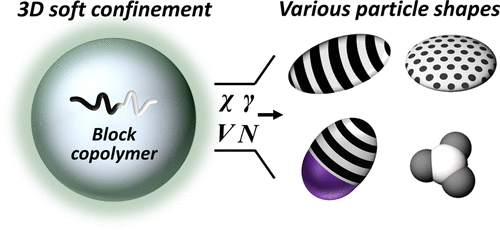当前位置:
X-MOL 学术
›
ACS Macro Lett.
›
论文详情
Our official English website, www.x-mol.net, welcomes your feedback! (Note: you will need to create a separate account there.)
100th Anniversary of Macromolecular Science Viewpoint: Block Copolymer Particles: Tuning Shape, Interfaces, and Morphology
ACS Macro Letters ( IF 5.8 ) Pub Date : 2020-02-13 , DOI: 10.1021/acsmacrolett.0c00020 Jaeman J Shin 1 , Eun Ji Kim , Kang Hee Ku , Young Jun Lee , Craig J Hawker 1 , Bumjoon J Kim
ACS Macro Letters ( IF 5.8 ) Pub Date : 2020-02-13 , DOI: 10.1021/acsmacrolett.0c00020 Jaeman J Shin 1 , Eun Ji Kim , Kang Hee Ku , Young Jun Lee , Craig J Hawker 1 , Bumjoon J Kim
Affiliation

|
Confined assembly of block copolymers (BCPs) is receiving increasing attention due to the ability to create unconventional morphologies that cannot be observed in the corresponding bulk systems. This effect is further driven by the simplicity and versatility of these procedures for controlling the shape of particles prepared by 3D soft confinement of BCPs in emulsions. By taking advantage of a mobile emulsion interface, the one-step formation of nonspherical BCP particles through spontaneous deformation is possible with design principles and theoretical models for controlling shape/nanostructure now being established. This Viewpoint highlights strategies for shape tuning of BCP particles, currently accessible shapes, their controllability, and potential application. The emergence of 3D soft confinement of BCPs and related theory is overviewed with a focus on current strategies, types of nonspherical shapes achieved, and structure–property relationships for nonspherical BCP particles. Finally, the applications and future perspectives for these materials are discussed.
中文翻译:

高分子科学 100 周年观点:嵌段共聚物粒子:调整形状、界面和形态
嵌段共聚物 (BCP) 的受限组装由于能够产生在相应的本体系统中无法观察到的非常规形态而受到越来越多的关注。这种效果进一步受到这些程序的简单性和多功能性的推动,这些程序用于控制通过乳液中 BCP 的 3D 软限制制备的颗粒形状。通过利用移动乳液界面,通过自发变形一步形成非球形 BCP 颗粒是可能的,目前正在建立控制形状/纳米结构的设计原则和理论模型。该观点强调了 BCP 粒子形状调整的策略、当前可访问的形状、它们的可控性和潜在应用。概述了 BCP 的 3D 软约束和相关理论的出现,重点关注当前策略、实现的非球形形状类型以及非球形 BCP 粒子的结构-性质关系。最后,讨论了这些材料的应用和未来前景。
更新日期:2020-02-13
中文翻译:

高分子科学 100 周年观点:嵌段共聚物粒子:调整形状、界面和形态
嵌段共聚物 (BCP) 的受限组装由于能够产生在相应的本体系统中无法观察到的非常规形态而受到越来越多的关注。这种效果进一步受到这些程序的简单性和多功能性的推动,这些程序用于控制通过乳液中 BCP 的 3D 软限制制备的颗粒形状。通过利用移动乳液界面,通过自发变形一步形成非球形 BCP 颗粒是可能的,目前正在建立控制形状/纳米结构的设计原则和理论模型。该观点强调了 BCP 粒子形状调整的策略、当前可访问的形状、它们的可控性和潜在应用。概述了 BCP 的 3D 软约束和相关理论的出现,重点关注当前策略、实现的非球形形状类型以及非球形 BCP 粒子的结构-性质关系。最后,讨论了这些材料的应用和未来前景。



























 京公网安备 11010802027423号
京公网安备 11010802027423号